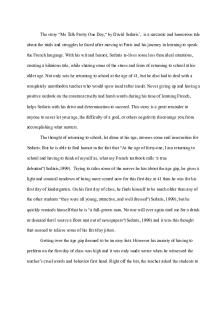Revised First Draft - Critical analysis on Me Talk Pretty One Day PDF

| Title | Revised First Draft - Critical analysis on Me Talk Pretty One Day |
|---|---|
| Author | Veronica Chamberland |
| Course | English Composition I |
| Institution | Southern New Hampshire University |
| Pages | 3 |
| File Size | 49.5 KB |
| File Type | |
| Total Downloads | 71 |
| Total Views | 158 |
Summary
Critical analysis on Me Talk Pretty One Day...
Description
“Me Talk Pretty One Day” by David Sedaris teaches others what it is like to be a 41-year-old, non-traditional French class student in college. Sedaris’s writing is effective in achieving his purpose. His essay is casual, very easy to read, and relatable. He claims that he had to overcome challenges and obstacles to achieve his educational goal of learning French. He decides not to give up, overcomes his obstacles, and enjoys the satisfaction of doing so. Sedaris’s main claim of having to overcome challenges and obstacles to achieve the educational goal of learning French is well argued because the author includes personal stories, experiences, and how he overcame them in a humorous way. One way in which Sedaris convinces his audience is by talking about how one of the challenges he had to overcome were his insecurities. With Sedaris being a middle-aged man, he feels old, scared, unattractive, not very well dressed, and intimidated by other students’ confidence. Sedaris compares himself to Pa Kettle, “As an added discomfort, they were all young, attractive, and well dressed, causing me to feel not unlike Pa Kettle trapped backstage after a fashion show” showing how he feels out of place and not quite fitting in [ CITATION Sed99 \l 1033 ]. Starting an educational goal at his age was an insecurity he must overcome. While expressing humor by reminiscing about a time, when he was scared about a failed nursing student injecting him with horse tranquilizer, he was able to compare how he was feeling twice as scared and nervous about taking on this journey. In addition to dealing with his insecurities, Sedaris had to face not only his classmates, but his teacher as well. Sedaris also convinces his readers of how challenging achieving your educational goals can be by describing his teacher as very harsh and unsupportive. She would constantly belittle him and his classmates. At one point Sedaris’s teacher goes as far as telling him that she really, really hates him. Rather than showing frustration with the teacher’s behavior, he creates words as
a coping mechanism when he doesn’t understand what she says. The teacher emphasizes his lack of understanding and scorns him when she says ‘“Were you always this palicmkrexjs?” she asked. “Even a fiuscrzsws tociwegixp knows that a typewriter is feminine [ CITATION Sed99 \l 1033 ].”’ With how embarrassed Sedaris feels about the situation, he demonstrates how he copes with it with his many made-up words. While dealing with his insecurities and his teacher, Sedaris realizes that he is not alone. Furthermore, Sedaris describes how his only comfort was knowing that he wasn’t alone and shares conversations he had with other students in order to convince his readers. One of his classmates admits to “Sometimes me cry alone at night [ CITATION Sed99 \l 1033 ].” It is then when Sedaris realizes that others must overcome their insecurities too. Right when he thought that he would never improve, he was able to understand every word that his teacher said. This was the moment when he started to enjoy the satisfying rewards of overcoming his challenges while learning French such as bonding with classmates and finally understanding every word anyone said. Sedaris's use of personal examples, experiences, and his sense of humor convince his audience because they can relate to his challenges and obstacles and his sense of humor engages them. At the start, Sedaris felt insecure and unmotivated until he shared similar experiences with his peers to reach his goals. This made him realize that he was not alone in his journey. Every situation has a bright side, one simply must find it. To conclude, a great deal can be learned about critical thinking, analysis and revision when writing one’s own work and analyzing someone else’s. When writing one’s own work, there can never be too much revision or feedback. There is always a way to improve one’s work and make it better. When analyzing someone else’s work, one thing that can be taken away from
critical thinking is the importance and relevance of arguments and ideas as well as the reflection of one’s assumptions, values and beliefs....
Similar Free PDFs

Me Talk Pretty One Day revised
- 6 Pages

Me talk pretty one day ENG 122
- 2 Pages

Me Talk Pretty One Day copy
- 5 Pages
Popular Institutions
- Tinajero National High School - Annex
- Politeknik Caltex Riau
- Yokohama City University
- SGT University
- University of Al-Qadisiyah
- Divine Word College of Vigan
- Techniek College Rotterdam
- Universidade de Santiago
- Universiti Teknologi MARA Cawangan Johor Kampus Pasir Gudang
- Poltekkes Kemenkes Yogyakarta
- Baguio City National High School
- Colegio san marcos
- preparatoria uno
- Centro de Bachillerato Tecnológico Industrial y de Servicios No. 107
- Dalian Maritime University
- Quang Trung Secondary School
- Colegio Tecnológico en Informática
- Corporación Regional de Educación Superior
- Grupo CEDVA
- Dar Al Uloom University
- Centro de Estudios Preuniversitarios de la Universidad Nacional de Ingeniería
- 上智大学
- Aakash International School, Nuna Majara
- San Felipe Neri Catholic School
- Kang Chiao International School - New Taipei City
- Misamis Occidental National High School
- Institución Educativa Escuela Normal Juan Ladrilleros
- Kolehiyo ng Pantukan
- Batanes State College
- Instituto Continental
- Sekolah Menengah Kejuruan Kesehatan Kaltara (Tarakan)
- Colegio de La Inmaculada Concepcion - Cebu












